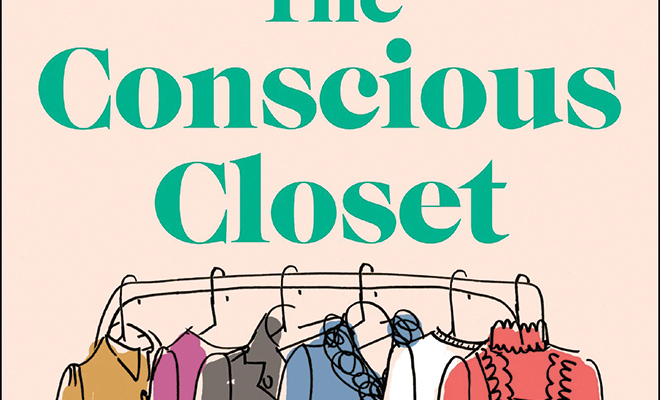
The Conscious Closet by Elizabeth L. Cline and Stop Telling Women to Smile: Stories of Street Harassment and How We’re Taking Back Our Power by Tatyana Fazlalizadeh
Your clothes are laid out for tomorrow. You’ll get up in the morning, jump out of the shower, into your outfit and out the door because it’s a big day. You’ll look sharp, competent and responsible, and you’ll feel that way, too. In The Conscious Closet by Elizabeth L. Cline, you’ll learn how to buy clothes that make it happen.
Everybody needs things to wear. Chances are, in fact, that you’ve got clothes on right now, which makes you an end user of a global industry that accounts for 3 percent of the Earth’s economy and provides jobs for “hundreds of millions of people around the world…” Without thinking about it specifically, you’ve contributed to a $2.5 trillion-dollar worldwide business. And for that, your closet is packed.
The old saying that we must dress for success is hard to do when you’re overwhelmed by wardrobe, so the first thing, says Cline, is to empty your closet and get rid of that which doesn’t fit, doesn’t fit in, and that never really was your style anyhow. In the U.S. each year, nearly 24 billion pounds of wearables are thrown away, she says, so don’t add to it; instead, donate and take a tax deduction but know this: 80 percent of your donation will go to “rag traders,” and most of their castoffs are shipped overseas “in a global trade worth almost $4 billion annually.”
If this seems wasteful, you’re right. So instead, says Cline, give your unwanted fashion a new life by selling or swapping it. Do good by knowing where your clothing was made and if it was made sustainably. Learn how to thrift-shop; invest in quality clothing that will last years and that you’ll feel good wearing; and finally, learn the art of repair to keep the things you wear from wearing out.
The second half is where the goodness lies. Cline explains the impact you make by shopping wisely in today’s world and why fast-fashion and fads are bad for you, your wallet and the global economy. Reading it’s like unbuttoning your waistband after Thanksgiving dinner: it’s surprisingly easy, it makes plain sense, and you know you’ll be happier once you do it. The best place for this book, perhaps, is in the hands of a college grad who’s just now building a wardrobe, or for anyone who’s looking to dress upward. If that’s you, then The Conscious Closet has what you need, all laid out.
Stop Telling Women to Smile: Stories of Street Harassment and How We’re Taking Back Our Power by Tatyana Fazlalizadeh
Heeeeey, look over here!
You look fine today, Mama, Sugar, Honey, Baby, fill-in-the-blank with names you’re called by men you don’t know. Just think, Sweetie, Pretty, you were minding your business before this monkey business started. And just know, by reading Stop Telling Women to Smile by Tatyana Fazlalizadeh, that others deal with it, too.
Like many women, Tatyana Fazlalizadeh spent her teen years in public “not wanting to be seen.” Catcalls, creepy comments, unwanted compliments about her young body followed her from street to sidewalk, coming from men who made her feel afraid, ashamed and harassed. The “sheer quantity” of it struck her as she got older and in 2012, Fazlalaizadeh, a street artist, started a movement she calls Stop Telling Women to Smile.
The most common response to street harassment, she says, is anxiety, a lingering dread of what could happen–physical violence, stalking, emotional terror–whether one interacts with a harasser or not. For many women, harassment becomes a part of their daily lives.
Says Fazlalizadeh, men who engage androgynous women in unwanted ways “are particularly likely to harass masculine women” out of a false sense of their own masculinity. Women of color receive “markedly different” harassment from white men than from men of their own races. Pregnant women receive unwelcome touches, as though they’re good-luck charms; and Muslim women are verbally attacked for their clothing. What can be done? Fazlalizadeh says that she sees hope for today’s children, who are raised learning not to harass, but beyond that, the solution “is a large question that can have many answers.”
Give yourself a minute to skim, and it may seem like the book is little more than same-but-different. Dig deeper and you might shudder. Tatyana Fazlalizadeh makes this book feel like a raw gallery performance; it shouts with power but not a lot of caution. Some of the What Women Want to Say to Street Harassers sidebars come off as advice, and safety isn’t stressed nearly enough there. There’s strength in Fazlalizadeh’s words and they’re stand-up-and-scream inspiring, but they just need a hair more prudence. Yet this is an invaluable book for any women’s group, a great launching point for conversations with teens of any gender, and parents will absolutely want to read it. ■







